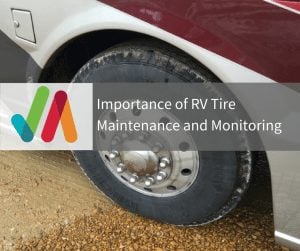 Our team cannot stress enough the importance of monitoring the health and condition of your RV tires – it’s one of the most important RV maintenance activities. The tires on your motorhome, fifth wheel, or travel trailer are designed to perform in various conditions and under various levels of stress. They are what separates you and your RV from the hard asphalt or pavement as you and your family travel down the road at 55-70 miles an hour.
Our team cannot stress enough the importance of monitoring the health and condition of your RV tires – it’s one of the most important RV maintenance activities. The tires on your motorhome, fifth wheel, or travel trailer are designed to perform in various conditions and under various levels of stress. They are what separates you and your RV from the hard asphalt or pavement as you and your family travel down the road at 55-70 miles an hour.
While they are designed to operate in cold, hot, and wet weather, as well as under heavy loads, they do have limits. Understanding those limits and the operating parameters of your RV tires will allow you to make the necessary adjustments when needed. Taking care of your tires and understanding their health can certainly save you money, but possibly even your life—should the worst happen, and a tire fail at the wrong time.
Know the Weight of your Vehicle and your Tires’ Weight Rating
Make sure the Gross Vehicle Weight of your RV does not exceed the Gross Vehicle Weight Rating of your tires, and that the load on your tires is distributed evenly. Here is a link to a great resource from Goodyear® that provides additional details and a “how to” for understanding the weight ratings and load distributions of your vehicle and its tires: Goodyear Tire PDF. Proper load distribution on your tires will enhance the overall performance of your RV. You likely will notice improved handling, better fuel economy, as well as proper and maintained breaking ability.
Know the Age of Your Tires
Unlike your car, which is often driven more regularly than your RV, you shouldn’t use just the tread wear on your tires as an indicator of whether you’re ready for new tires. Most tire manufacturers, such as Goodyear® and Michelin®, do not quote a specific age beyond the manufacture date by which you should replace your tires. This is because there are a number of factors that affect a tire’s lifespan. However, Michelin® does recommend keeping five years in mind, and never going past ten years. Some of the factors that impact a tire’s lifespan include:
- More frequent usage results in longer life.
- Length of storage under load and without rotation reduces tire life expectancy. For instance, letting your RV sit for six months under load isn’t healthy for your tires.
- Constant use in warmer climates can affect a tire’s lifespan due to greater ozone exposure, per Goodyear®.
- Keeping proper tire pressure and performing regular tire rotations can extend the life of your tires.
Needless to say, Maintain My RV can assist you in staying on top of the critical maintenance of your tires. In fact, tire maintenance items are already preloaded for you in Maintain My RV. However, even with the best maintenance practices, tires—like anything—can still fail. Along with your regular maintenance, a tire monitoring system can provide peace of mind and protection against a possible worst-case scenario.
There are many tire-monitoring systems, and we encourage you to educate yourself on the various features and capabilities of those systems on the market today. We recommend you consider the TST Tire Pressure Monitoring System – it includes various features and functions we have found to be useful, such as continuous scrolling of both the PSI and temperature of each tire. While TST’s tire pressure monitors can be found both online and in retail storefront stores, be sure to purchase them from someone who not only will stand behind the products they sell with customer support, but who also actually uses the product. One example is Eric and Tami Johnson at TechnoRV.com. TechnoRV is as passionate as we are about improving your RV experience and lifestyle.
In summary, keep your RV tires in the best condition you can by sticking to a regular maintenance schedule and monitoring their condition. As always, be safe out there.
